Performance
SPECviewperf
11.0
In the tests on professional graphics
cards, first of all, we ran SPECviewperf, this software has become an industry
standard for the evaluation of graphics workstations. SPECviewperf sends
predefined sequences of OpenGL instructions to the graphics card driver,
describing the rotations of the complex models that are typical of many
professional applications. By simulating those operations rather than by the
original ones, the evaluation (benchmark) reported the geometric performance of
a graphics card which is identified by the hardware features as well as
optimized drivers.
The scripts integrated into SPECviewperf
version 11 copy the user's activities in wireframe mode in the following
professional applications (the names of the corresponding tests are put in
parentheses: LightWave (lightwave-01), CATIA (CATIA-03), EnSight (ensight-04),
Maya (maya-03), Pro / ENGINEER (proe-05), SolidWorks (sw-03), Siemens
Teamcenter Visualization Mockup (tcvis-02) and Siemens NX (snx-01).

SPECviewperf
11.0, catia-03

SPECviewperf
11.0, ensight-04

SPECviewperf
11.0, lightware-01
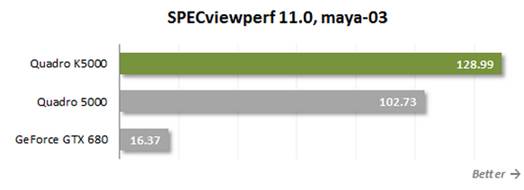
SPECviewperf
11.0, maya-03
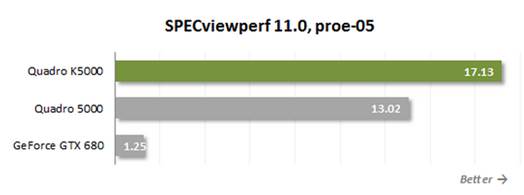
SPECviewperf
11.0, proe-05

SPECviewperf
11.0, sw-02

SPECviewperf
11.0, tcvis-02

SPECviewperf
11.0, snx-01
The new Nvidia Quadro K5000 is clearly
superior to its predecessor the Quadro 5000. The different distance is shown
through the applications, but the Quadro K5000 always takes the lead, which
demonstrates the value of the advanced Kepler architecture. It is particularly
good in the tests of ht-04, tcvis-02 and snx-0, where the Quadro K5000 is
70-80% faster than the Quadro 5000. On the other hand, the distance is not
larger than 10% in the LightWave-01 and sw-02 scenarios.
Meanwhile, SPECviewperf makes clear that
the use of gaming graphics card for professional applications is not a good
idea. Although the GeForce GTX 680 has the similar architecture to the Quadro
K5000 and higher clock speeds, it has major problems in dealing with complex
models based on OpenGL. Its speed is much lower compared to the dedicated
solutions with optimized drivers.
We also use SPECviewperf 11.0 to test the
effectiveness of the full screen antialiasing on performance. The charts below
are based on the standard SPECviewperf tests made with different FSAA
turned-on modes.
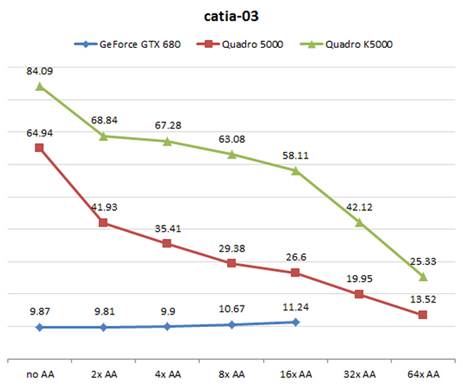
Catia-03

Ensight-04
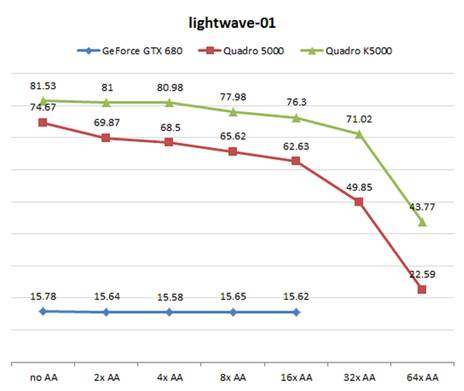
Lightwave-01

Maya-03

Proe-05
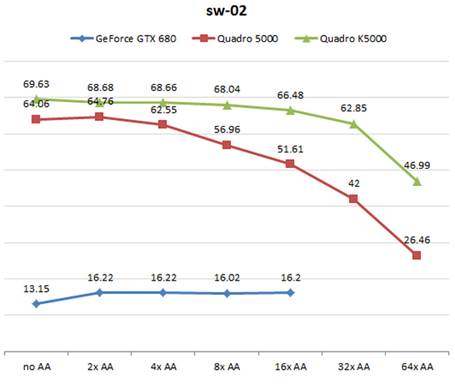
Sw-02
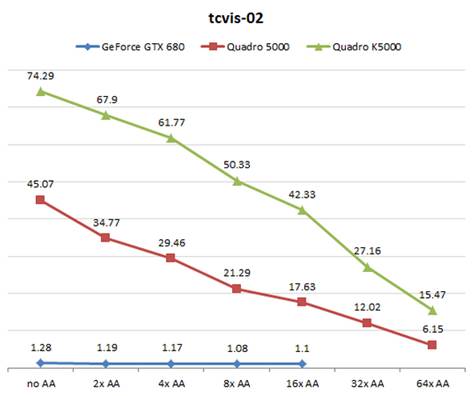
Tcvis-02
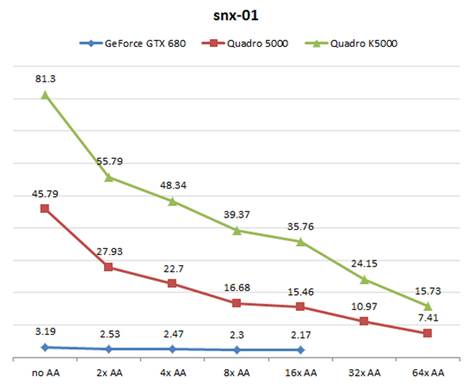
Snx-01
As planned, the FSAA causes a performance
hit, but the new Quadro K5000 does not slow down as much as the Quadro 5000.
Consequently, the newer card is twice faster than its previous generations in
the FSAA 32x and 64x modes.
While providing a general concept about the
performance of a graphics card, SPECviewperf 11.0 is as a synthetic standard.
Therefore, we would like to add its number with what we have in real life
professional applications.
Autodesk
3ds Max 2011
We used the professional version of the SPEC
benchmark to test the performance of the graphics card in one of the most
popular 3D modeling. Among other things, this version was taken note for using
very complex models with some 32 million polygons and assessing the
effectiveness separately for common and complex models.
It should be noted that Nvidia optimizes
the professional solutions for 3ds Max projection windows by providing a
special mini-driver that supersedes the standard DirectX drivers in the
software and ensures higher performance for the Quadro series.

3ds
Max 2011, GPU Composite Score
The mini-driver has only compatibility with
professional NVIDIA solutions, which explains the advantage of Quadro K5000 is
50% much more than the GeForce GTX 680. The benefits of Kepler architecture
also indicate that the new card is 10% newer than the Quadro 5000. However, the
high performance of the new professional card based on Kepler is even
manifested more evidently with the highly sophisticated-level 3D models.

3ds
Max 2011, Large Model GPU
The Quadro K5000 runs up to 20% faster than
the Quadro 5000 when processing the model of a city built on 32 million
polygons. It is also 85% faster than the gaming cards with the same hardware
architecture. Of course, we've seen the numbers that are even more impressive
than in SPECviewperf, but we should remember that 3ds Max is one of the 3D
modeling kits working through DirectX.
The overall performance scores might not
reflect the whole picture well. We are likely to get a better understanding by
analyzing the secondary performance parameters exposed by the benchmark.
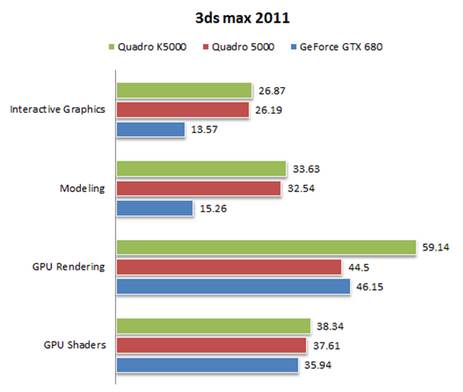
3ds
Max 2011
As you can see, the cards are based on
Kepler that are largely outperformed the previous generations based on Fermi in
terms of GPU’s described components. That is just another proof that the GK104
is optimized for high performance computing.
Autodesk
AutoCAD 2013
This is another popular 3D modeling kit
using DirectX. With 3ds Max, Nvidia provides special support for the
development of AutoCAD, but unfortunately, the corresponding mini-driver for
the Quadro series has not been updated in a long time. Its latest version is
only compatible with AutoCAD 2011. That is the reason why the users of this
software cannot enjoy the full of benefits from the advantages offered by
Nvidia’s latest professional cards. This means that there is no basic
difference between the Quadro and GeForce product series based on the Kepler
architecture.

AutoCAD
2013, Total Score
As you can see the GeForce GTX 680 gaming
cards approach to the performance of Quadro K5000. The latter products are not
much different from the previous-generation professional cards, except for
specific situations. They are different when you activate the specific viewing
types in AutoCAD 2013.

AutoCAD
2013
The Quadro K5000 turned out to be better
when compared to the other graphics cards to handle 2D design drawings with the
Hidden style when the objects are represented as frames, and you cannot see
their back edges. The professional cards based on Fermi are the best in the
Wireframe and Conceptual modes while the most effective gaming cards are with
the Realistic style.
It should be taken note that if Nvidia
launches its mini-driver for AutoCAD 2013, the situation may change considerably.
Considering the previous versions, we are able to expect the Quadro series to
be many times faster than they are at present with the appropriate software
support.
Maxon
Cinema 4D (Cinebench R11.5)
Maxon Cinema 4D is a popular software kit
for 3D modeling and animation. Its speed can be assessed by using the dedicated
Cinebench’s assessment methods. But the latter products employs the tool of
CINEMA 4D version R11.4, according to the developers, can also provide some
notions of a graphics card performance in the latest CINEMA 4D R14.

Cinebench
11.5, OpenGL
According to Cinebench, the new
professional card Quadro K5000 based on Kepler is 14% faster than the
Fermi-based Quadro 5000